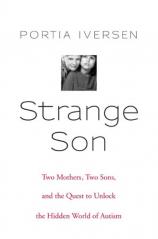Strange Son: Two Mothers, Two Sons and the Quest to Unlock the Hidden World of Autism
Review
Strange Son: Two Mothers, Two Sons and the Quest to Unlock the Hidden World of Autism
When
a successful television writer and a brilliant but desperate Indian
educator link forces, miracles can happen.
Both were mothers of "strange" sons. Portia Iversen's child Dov was
trapped, seemingly hopelessly, in the bleak landscape of profound
autism. Often presumed to be retarded, assailed by bizarre and
antisocial impulses, most autistic children exhibit low or no
communication skills and have little prospect for a typical life.
But Tito, the son of Soma Mukhopadhyay in Bengal, was a different
kind of autistic. Though he too exhibited disturbing and disruptive
behaviors that were escalating as he approached adolescence, he had
achieved the ability to write on a keyboard, communicating his
insights from the autistic's universe, as well as composing
poetry.
Iversen and her husband have devoted their lives to finding a cure
for autism through CAN (Cure Autism Now), an organization they
founded. With the couple's backing, Soma and Tito came to the U.S.
and Soma taught Dov as she had taught Tito. In a remarkably short
time, Dov was also using a keyboard, expressing thoughts and
dredging up memories that revealed an intellectual capacity well
above the average.
The methodology that Soma had hit upon is generally called
Facilitated Communication (FC) and was originated by Australian
Rosemary Crossley. It offers a ray of hope for families of
autistics. Whenever Tito demonstrated his abilities (including a
segment on "60 Minutes"), there was a surge of interest among
parents who were already convinced that their autistic child
possessed innate intelligence but frustrated at having no way of
unlocking it. Tito and Soma seemed to have a key, and Soma became
deluged with requests for help.
Meanwhile, Iversen exulted in the obvious changes in Dov from
Soma's ministrations. But it wasn't an absolute win-win. Tito (and
Dov) still exhibited highly unsocial behaviors that were a barrier
to recruiting scientists to study him. Tito was unable, for
example, to control his physical and emotional reactions to an
attempted MRI, thus losing a valuable possibility for deeper
understanding of what makes him function. Iversen felt that along
with the unlocking of the mind had to come sufficient adjustment to
the ordinary world and its requirements. Otherwise, the parent was
left with a possibly brilliant but still physically unmanageable
offspring.
Many parents view FC as a miracle that has blessed them with the
ability to communicate with heretofore verbally isolated children.
But some institutions and psychologists refuse to validate the
method because it sometimes involves physical prompting by a
facilitator to stimulate the movement of the autistic person's hand
on the keyboard. There's a chance therefore that the facilitator
controls the output. Despite test situations concocted by
proponents of FC to overcome these objections, the method remains
in doubt among the scientific community, some of whom see it as
reminiscent of séances and parapsychological parlor
tricks.
Iversen is trying to bring more scientific minds into the process,
offering FC as, if not a cure, certainly a hopeful avenue of
exploration into this puzzling and debilitating disorder. Anyone
with an autistic child in the family should read STRANGE SON and
draw his/her own conclusions.
Reviewed by Barbara Bamberger Scott on January 23, 2011
Strange Son: Two Mothers, Two Sons and the Quest to Unlock the Hidden World of Autism
- Publication Date: December 28, 2006
- Genres: Nonfiction
- Hardcover: 416 pages
- Publisher: Riverhead Hardcover
- ISBN-10: 1573223115
- ISBN-13: 9781573223119




